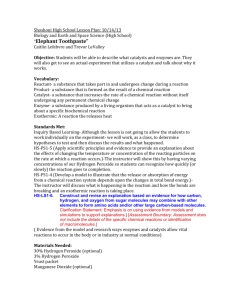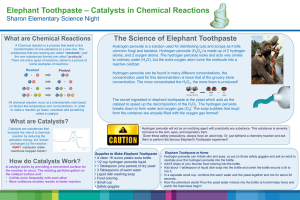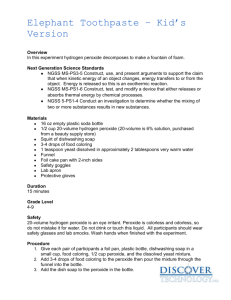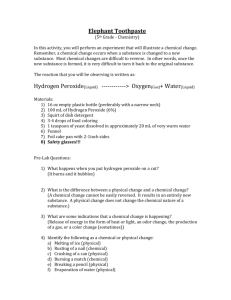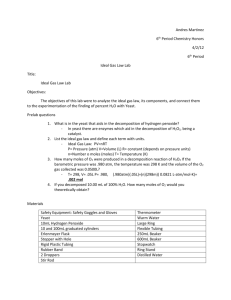docx
advertisement
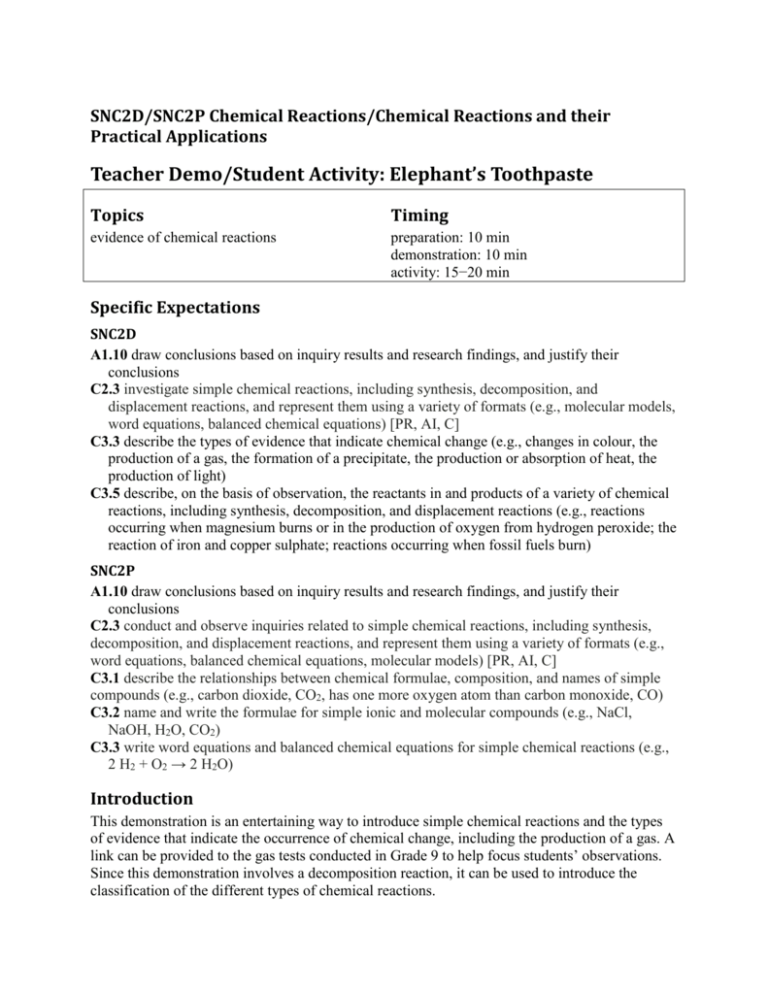
SNC2D/SNC2P Chemical Reactions/Chemical Reactions and their Practical Applications Teacher Demo/Student Activity: Elephant’s Toothpaste Topics Timing evidence of chemical reactions preparation: 10 min demonstration: 10 min activity: 15−20 min Specific Expectations SNC2D A1.10 draw conclusions based on inquiry results and research findings, and justify their conclusions C2.3 investigate simple chemical reactions, including synthesis, decomposition, and displacement reactions, and represent them using a variety of formats (e.g., molecular models, word equations, balanced chemical equations) [PR, AI, C] C3.3 describe the types of evidence that indicate chemical change (e.g., changes in colour, the production of a gas, the formation of a precipitate, the production or absorption of heat, the production of light) C3.5 describe, on the basis of observation, the reactants in and products of a variety of chemical reactions, including synthesis, decomposition, and displacement reactions (e.g., reactions occurring when magnesium burns or in the production of oxygen from hydrogen peroxide; the reaction of iron and copper sulphate; reactions occurring when fossil fuels burn) SNC2P A1.10 draw conclusions based on inquiry results and research findings, and justify their conclusions C2.3 conduct and observe inquiries related to simple chemical reactions, including synthesis, decomposition, and displacement reactions, and represent them using a variety of formats (e.g., word equations, balanced chemical equations, molecular models) [PR, AI, C] C3.1 describe the relationships between chemical formulae, composition, and names of simple compounds (e.g., carbon dioxide, CO2, has one more oxygen atom than carbon monoxide, CO) C3.2 name and write the formulae for simple ionic and molecular compounds (e.g., NaCl, NaOH, H2O, CO2) C3.3 write word equations and balanced chemical equations for simple chemical reactions (e.g., 2 H2 + O2 → 2 H2O) Introduction This demonstration is an entertaining way to introduce simple chemical reactions and the types of evidence that indicate the occurrence of chemical change, including the production of a gas. A link can be provided to the gas tests conducted in Grade 9 to help focus students’ observations. Since this demonstration involves a decomposition reaction, it can be used to introduce the classification of the different types of chemical reactions. Materials chemical safety goggles lab coat or apron protective gloves 100 mL 6% hydrogen peroxide solution, H2O2(aq) bottle of liquid dish detergent dropper bottle containing food colouring (any colour) warm water 1 packet of dry yeast 100 mL graduated cylinder 500 mL graduated cylinder (or 591 mL plastic pop bottle) large deep pan, bin, or plastic tray 250 mL beaker glass stirring rod Safety Considerations Provide MSDS sheets for all chemicals used. Hydrogen peroxide is an oxidizing agent and body tissue irritant. Avoid skin or eye contact. Safety goggles and gloves should be worn when handling hydrogen peroxide. Flush eyes and skin with water immediately and for 15 min if you come into contact with hydrogen peroxide. If ingested, do not induce vomiting and call poison control immediately. A flame is used to determine the presence of oxygen. Keep long hair tied back and loose clothing secured when using flames. Ensure that the flame is extinguished before disposing of the splint. Also, remind students of emergency procedures related to fire (extinguishers, exits, etc.). Hazardous Materials Identification System Rating (0-minimal 1-slight 2-moderate 3-serious 4-severe) 6% hydrogen peroxide, H2O2(aq) Procedure Wear appropriate PPE: chemical safety goggles, lab coat or apron, and protective gloves. Prepare the following before performing the demonstration. 1. Using the 100 mL graduated cylinder, measure 100 mL of 6% hydrogen peroxide solution and pour into the 500 mL graduated cylinder (or plastic pop bottle). 2. Place the 500 mL graduated cylinder (or plastic pop bottle) into the pan or tray. 3. Add 4–5 drops of liquid dish detergent and 3–4 drops of food colouring to the hydrogen peroxide. During class: 4. Measure 60 mL of warm water into the 250 mL beaker, then empty the packet of dry yeast into it. Use the stirring rod to mix well. 5. 6. 7. Predict/Explain Ask students to predict what will happen when the yeast mixture is added to the hydrogen peroxide. Observe Quickly add the yeast mixture to the 500 mL graduated cylinder. Provide time for students to record their observations. Explain Ask students to explain their observations. Disposal The product mixture will contain water, yeast, and detergent, so it can be safely flushed down the sink with running water. What happens? When the yeast solution is added to the hydrogen peroxide mixed with detergent, an eruption of foam results that rises out of the graduated cylinder or pop bottle. The bubbles in the foam are filled with the oxygen gas that is produced. How does it work? Hydrogen peroxide slowly decomposes spontaneously to form water and oxygen gas. The rate of this reaction is increased in the presence of light. Several catalysts also significantly increase the rate of this reaction. Catalysts are substances that increase the rate of a reaction by lowering the activation energy of that reaction. Catalysts differ from reactants in that they are not consumed in the reaction. Manganese(IV) oxide, potassium iodide, sodium iodide, and yeast are examples of catalysts for this reaction. Yeast is used in this demonstration because it is the least harmful to the environment and is readily available in grocery stores. yeast Decomposition reaction of hydrogen peroxide: 2 H2O2(aq) → 2 H2O(l) + O2(g) Teaching Suggestions/Hints 1. 2. 3. 4. 5. 6 % hydrogen peroxide solution is available from most beauty supply stores. This demonstration results in a great deal of foam. Ensure that you perform the experiment in a pan to aid with the clean up. Any of the other suggested catalysts (manganese(IV) oxide, potassium iodide, and sodium iodide) also work well. See website links in Additional Resources. This demonstration could easily be modified into a student activity and investigated in small groups. Students should use a smaller graduated cylinder (e.g., 100 mL) and smaller quantities of hydrogen peroxide and yeast mixture (e.g., 10 mL of each). Ensure that students wear PPE: lab coats or aprons and chemical safety goggles as well as protective gloves. Dry yeast may also be added directly to the hydrogen peroxide. Next Steps Challenge students to design and conduct a test for the gas produced in this reaction. For example, a glowing splint placed near the foam should glow brighter due to the presence of oxygen. Challenge students to write the word and chemical equations for this reaction. This demonstration/activity could also be used to introduce some concepts that will be learned in senior level chemistry courses: rates of reaction; oxidation and reduction. For example, students could design an experiment to determine the effect of the concentration of hydrogen peroxide on the reaction rate. A similar experiment could also be conducted to determine which catalyst has the greatest effect on the rate of the reaction. Additional Resources 1. 2. Video of demonstration along with explanations and variations: http://www.stevespanglerscience.com/experiment/hydrogen-peroxide-eruption More detailed explanation of the role of catalysts in chemical reactions: http://www.sciencelearn.org.nz/Contexts/Nanoscience/Science-Ideas-andConcepts/Chemical-reactions-and-catalysts


